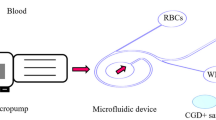Summary
There is a continuing need to develop reliable non-invasive methods to aid in the early diagnosis of disseminated candidiasis. We report the development of a solid phase “sandwich” radioimmunoassay (RIA) for the detection of soluble cytoplasmic protein antigens (SPA) ofCandida albicans in patients with systemic candidiasis. SPA were prepared by ultrasonic disruption of blastospores ofC. albicans. Anti-SPA IgG was covalently linked to a solid phase of polyacrylamide-like microspheres. Standard amounts of patient sample or SPA in pooled normal human serum were reacted with the conjugated microspheres, washed and reacted with anti-SPA IgG-125I. The amount of antigen was directly correlated with the amount of bound125I-IgG anti-SPA. In a retrospective analysis, circulating SPA in the range of 0.5–1.6 µg/ml was detected in the serum of 12 of 19 patients (63%) with documented systemic candidiasis. There was no detectable SPA in the serum of 20 hospitalized patients with bacteremia, two patients with aspergillosis, one with cryptococcosis, and three with invasiveCandida tropicalis. We observed no cross-reaction of the RIA with mannan fromC. albicans, coccidioidin or culture filtrate antigen ofAspergillus fumigatus. There was significant inhibition of the RIA by serum samples from two patients with chronic candidiasis suggestive of anti-SPA antibody excess. The solid phase RIA to detect circulating SPA can provide a useful noninvasive method for the diagnosis of systemicC. albicans infection.
Zusammenfassung
Der Bedarf nach zuverlässigen nichtinvasiven Methoden zur Unterstützung der Frühdiagnose der disseminierten Candidiasis besteht nach wie vor. Wir berichten über die Entwicklung eines solid-phase „sandwich“ Radioimmunoassay (RIA) für den Nachweis löslicher zytoplasmatischer Proteinantigene (SPA) vonCandida albicans bei Patienten mit systemischer Candidiasis. Die SPA-Präparation erfolgt durch Ultraschallzerreißung von Blastosporen vonC. albicans. Anti-SPA IgG war an die feste Phase von Polyacrylamid-ähnlichen Mikrospheren fest gebunden. Standardmengen von Patientenproben oder SPA in gepooltem normalem menschlichem Serum wurde mit den konjugierten Mikrospheren in Reaktion gebracht, gewaschen und mit anti-SPA IgG-125J beschickt. Die Menge Antigen wurde mit der Menge von gebundenem125J-IgG anti-SPA direkt korreliert. In einer retrospektiven Analyse konnte zirkulierendes SPA in Mengen von 0,5–1,6 µg/ml im Serum von 12 von 19 Patienten (63%) mit nachgewiesener systemischer Candidiasis entdeckt werden. Im Serum von 20 stationären Patienten mit Bakteriämie, zwei Patienten mit Aspergillose, einem mit Cryptokokkose und drei mit invasiverCandida tropicalis-Infektion waren SPA nicht zu finden. Wir beobachteten keine Kreuzreaktion des RIA mit Mannan vonC. albicans, Coccidioidin oder Kulturfilterantigen vonAspergillus fumigatus. Der RIA wurde von zwei Serumproben zweier Patienten mit chronischer Candidose und dem Verdacht auf anti-SPA Antikörperüberschuß signifikant gehemmt. Der solidphase RIA zur Entdeckung zirkulierender SPA dürfte eine brauchbare nichtinvasive Methode zur Diagnose einer systemischenC. albicans-Infektion sein.
Similar content being viewed by others
Literature
Winston, D. W., Gale, R. P., Meyer, D. V., Young, L. S. UCLA Bone Marrow Transplantation Group: Infectious complications of human bone marrow transplantation. Medicine (Baltimore) 58 (1979) 1–31.
Edwards, J. E. Jr., Lehrer, R. I., Stiehm, E. R., Fischer, T. J., Young, L. S. SevereCandida infections: Clinical perspective, immune defense mechanisms, and current concepts of therapy. Ann. Intern. Med. 89 (1978) 91–106.
Edwards, J. E. Jr., Foos, R. Y., Montgomerie, J. Z., Guze, L. B. Ocular manifestations ofCandida septicemia: Review of 76 cases of hematogenousCandida endophthalmitis. Medicine (Baltimore) 53 (1974) 47–75.
Taschdjian, C. L., Kozinn, P. J., Cuesta, M. B., Toni, E. F. Serodiagnosis of candida infections. Am. J. Clin. Path. 57 (1972) 195–205.
Dee, T. H., Rytel, M. W. Detection ofCandida serum precipitins by counterimmunoelectrophoresis: An adjunct in determining significant candidiasis. J. Clin. Microbiol. 5 (1977) 453–457.
Filice, G., Yu, B., Armstrong, D. Immunodiffusion and agglutination tests forCandida in patients with neoplastic disease: Inconsistent correlation of results with invasive infections. J. Infect. Dis. 135 (1977) 349–357.
Weiner, M. H., Coats-Stephen, M. Immunodiagnosis of systemic candidiasis: Mannan antigenemia detected by radioimmunoassay in experimental and human infections. J. Infect. Dis. 140 (1979) 989–993.
Segal, E., Berg, R. A., Pizzo, P. A., Bennett, J. E. Detection ofCandida antigen in sera of patients with candidiasis by an enzymelinked immunosorbent assay-inhibition technique. J. Clin. Microbiol. 10 (1979) 116–118.
Miller, G. G., Witwer, M. W., Braude, A. L., Davis, C. E. Rapid identification ofCandida albicans septicemia in man by gas-liquid chromatography. J. Clin. Invest. 54 (1974) 1235.
Syverson, R. E., Buckley, H. R., Campbell, C. C. Cytoplasmic antigens unique to the mycelial or yeast phase ofCandida albicans. Infect. Immun. 12 (1975) 1184.
Lee, K. L., Buckley, H. R., Campbell, C. C. An amino acid liquid synthetic medium for the development of mycelial and yeast forms ofCandida albicans. Sabouradia 13 (1975) 148–153.
Lowry, O. H., Rosebrough, N. H., Farr, A. L., Randall, R. J. Protein measurement with the folin phenol reagent. J. Biol. Chem. 193 (1951) 265–275.
Vaitikaitus, J., Robbins, J. B., Nieschlay, E., Ross, G. T. A method for producing specific antisera with small doses of immunogen. J. Clin. Endocrinol. 33 (1971) 988.
Marchalonis, J. J. An enzymic method for the trace iodination of immunoglobulins and other proteins. Biochem. J. 113 (1969) 299–305.
Holmberg, K., Berdischewsky, M., Young, L. S. Serological diagnosis of invasive aspergillosis. J. Infect. Dis. 141 (1980) 656–664.
Kiehn, T. E., Bernard, E. M., Gold, J. W. M., Armstrong, D. Candidiasis: Detection by gas liquid chromatography of darabinitol, a fungal metabolite, in human serum. Science 206 (1979) 577–580.
McCracken, G. H. Jr., Sarff, L., Glode, M. P., Mize, S. G., Schiffer, M. S., Robbins, J. B., Gotschlich, E. C., Orskov, I., Orskov, F. Relation betweenEscherichia coli K-1 capsular polysaccharide antigen and clinical outcome in neonatal meningitis. Lancet II (1974) 246–251.
Hoffman, T. A., Edwards, F. A. Group-specific polysaccharide antigen and humoral antibody response in disease due toNeisseria meningitidis. J. Infect. Dis. 126 (1972) 636–644.
Author information
Authors and Affiliations
Rights and permissions
About this article
Cite this article
Stevens, P., Huang, S., Young, L.S. et al. Detection of candida antigenemia in human invasive candidiasis by a new solid phase radioimmunoassay. Infection 8 (Suppl 3), S334–S338 (1980). https://doi.org/10.1007/BF01639607
Published:
Issue Date:
DOI: https://doi.org/10.1007/BF01639607




